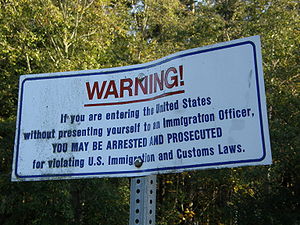By Madeline Zavodny
New estimates from the Pew Research Center suggest that the number of unauthorized immigrants is once again rising in the U.S. Although this turnaround from the sharp decline in the unauthorized population during the Great Recession is likely to be condemned by many, it’s actually good news.
Unauthorized immigration is a bellwether of the strength of the economy. Unlike legal immigrants who may have waited years or even decades for a visa, illegal immigrants respond quickly to changes in economic conditions. Inflows rise faster when the economy, especially the construction sector, is growing, and slow down when the economy is shrinking. This turnaround is consistent with other signs that the economy is recovering and that residential construction activity in particular is gaining steam—good news for homeowners.
The possible increase in the unauthorized population is also good news in that it may finally spur the House to pass immigration reform. But it’s critical that the House not use these numbers as a justification for even tougher border security. Economic forces, not border enforcement, drive illegal inflows. The Great Recession played a far bigger role in reducing unauthorized immigration than the tenfold increase in the Border Patrol’s budget over the last decade. The House Homeland Security Committee had the right idea to support a bill that removes last-minute additions to the Senate bill that double the number of Border Patrol agents along the U.S.-Mexico border and expand the fence.
Instead, the House should focus on addressing the fundamental factor that motivates most illegal immigration: jobs. Employers turn to undocumented immigrants because current immigration policy makes it impossible to bring in foreign workers quickly and legally when employers can’t find Americans to fill jobs. The current H-2A and H-2B temporary foreign worker programs require planning months in advance and following complicated rules. It’s far easier to hire an unauthorized immigrant.
To reduce unauthorized immigration, immigration policy needs to reproduce the flexibility that employers value in unauthorized workers. Allowing temporary foreign workers to easily move across employers is critical. Current policy ties H-2A and H-2B visa holders to their employers, increasing the potential for abuse and weakening market forces. If temporary foreign workers could freely move to an employer who offered them a higher wage or better working conditions, they would. Such mobility would force employers to raise wages when labor markets tighten, which would benefit competing American workers, too. The Senate bill creates far more mobility than current programs but still allows only pre-approved employers hire temporary foreign workers, not the spot labor market that employers need when trying to get motel rooms cleaned, meals cooked, or crops picked.
Keeping employers from turning to cheaper unauthorized workers requires more enforcement, but in the interior instead of along the U.S.-Mexico border. At the state level, policies requiring the use of E-Verify, such as the 2007 Legal Arizona Workers Act, appear to have been effective at reducing the number of unauthorized immigrant workers. The rise of such state laws has coincided with increased use of the H-2A system by farmers who can no longer rely on a ready supply of unauthorized immigrants. Requiring all employers to use E-Verify, as the Senate bill does, would help choke off the demand for unauthorized workers.
The third part of successfully reducing unauthorized immigration is increasing the scale of temporary foreign worker programs. Before the Great Recession, the unauthorized labor force was growing by about 350,000 workers per year. This dwarfed the roughly 110,000 H-2A and H-2B visas issued annually. The difference is even bigger when considering stocks instead of flows: from 2003 to 2007, the U.S. gained about 1.4 million unauthorized workers whereas there was virtually no change in the number of H-2A and H-2B visa holders, who have to return home every year.
When the economic recovery picks up steam, immigration policy should ensure enough foreign workers can enter legally. The new programs the Senate bill creates for less-skilled agricultural and non-agricultural workers are capped at levels roughly commensurate with previous inflows of low-skilled immigrant workers. However, the construction industry gets special adverse treatment in the Senate bill, with a maximum of only 15,000 visas annually regardless of the level of construction activity.
Finally, Congress needs to keep the issue of unauthorized immigration in perspective. Yes, it’s problematic to have some 12 million people living here illegally and it would be good to reduce future illegal inflows. But it’s at least as important to adopt an immigration policy that encourages more highly skilled immigrants to enter and remain in the U.S. The greatest economic gains will come from allowing more engineers, scientists and other professionals to come to the U.S., not from focusing on less-skilled immigrants.
Unauthorized immigrants have become a safety valve for the U.S. economy: they enter in greater numbers when needed, and they go where the jobs are. Their arrival in greater numbers is good news indeed. But sensible immigration reform that reduces the supply of and demand for unauthorized immigrants and admits more highly skilled immigrants would be even better news.
Madeline Zavodny is an adjunct scholar at the American Enterprise Institute and professor of economics at Agnes Scott College.
Source Article from http://www.forbes.com/sites/realspin/2013/10/01/unauthorized-immigrant-arrivals-are-on-the-rise-and-thats-good-news/
Unauthorized Immigrant Arrivals Are On The Rise, And That's Good News
http://www.forbes.com/sites/realspin/2013/10/01/unauthorized-immigrant-arrivals-are-on-the-rise-and-thats-good-news/
http://news.search.yahoo.com/news/rss?p=immigrant
immigrant – Yahoo News Search Results
immigrant – Yahoo News Search Results

